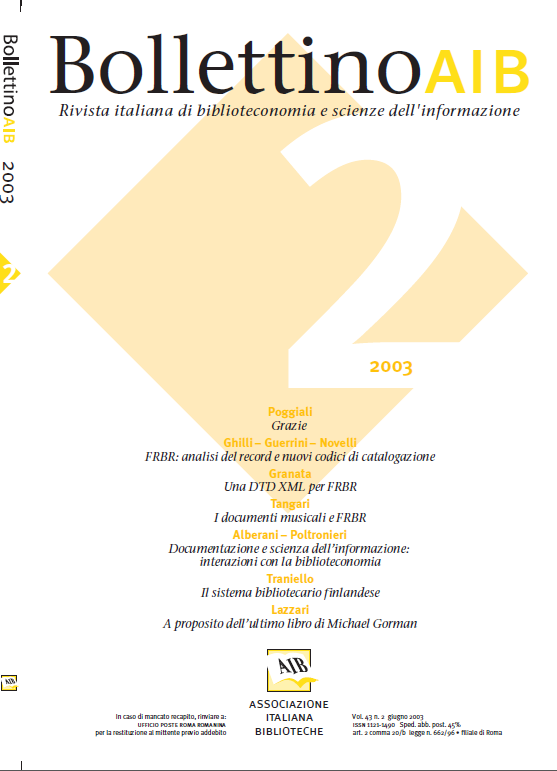A DTD XML for FRBR
Main Article Content
Abstract
W3C's recent introduction of the eXstensible Markup Language (XML) and the luck that it has encountered from its very first appearance have given rise to a multitude of projects in fields that differ considerably from one another. Apart from the structuring of documents, the sector for which it was originally invented, due to its synthatic potential, the language is by now quite widespread for numerous other uses, from the planning of data bases based on the use of DTD (Document Type Definition) and XML tables for the lay-out of their internal structure, to the verification of the completeness and correctness of the files given through their functionality of control and the convalidation of their structure, even going so far as the definition of logical data transmission formats that use XML as a simple structural support: the possibility of dividing information according to complex plans, strictly encased thanks to the use of beginning and end markers, does in fact make it possible to represent large classes of data in a relatively simple manner.
It is precisely with reference to this last aspect, that of data transmission, that various experiments have been carried out in the library field linked especially to problems of bibliographic interexchange and to the necessity of overcoming the limitations that the traditional uses of MARC formats have gradually shown in the new scenario of global communications and the interoperability of data that accompanies the diffusion of Internet.
Actually, although it does have some advantages with respect to the original formats, the introduction of XML does however continue to appear with a low added value, to the extent that it maintains their original structure, thus continuing to reproduce the same limits.
The hypothesis that it is intended to check in the article is that of using the FRBR model for the construction of this new format. What is proposed is the construction of a DTD for FRBR, implemented in reference to an abstract model, even while aware that some operational choices have to be made prior to its concrete application in the treatment of catalographic material. In particular, because of the way in which FRBR is structured, its main objective not being that of specifying a format for data management, it is clear that no limits for the possibility of data interconnection are fixed in it, while in the hypothesis of its practical application it becomes necessary to define on the one hand the “boundaries” of the record, and on the other the boundaries between the entities themselves: at what level of complexity should we arrive in understanding the different relationships described by the study and where should we fix the limit at which from different expressions of a same work we pass to works that differ from one another? These are only some of the questions posed by those who checked the usability of the model for cataloguing reasons: the proposal presented does not intend offering a definitive solution to these, dealing initially only with the analysis of the structural aspects which are subordinate to the translation of the model itself into XML. Possible modifications to the DTD can be discussed later following the definition of opportune user modalities.
Article Details

This work is licensed under a Creative Commons Attribution-ShareAlike 4.0 International License.
